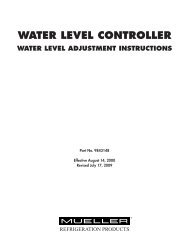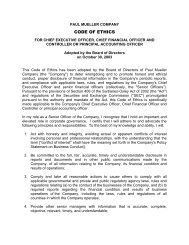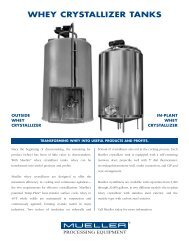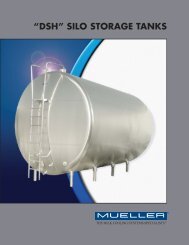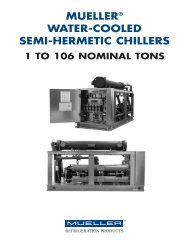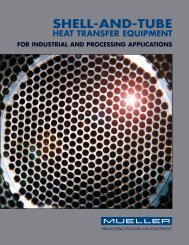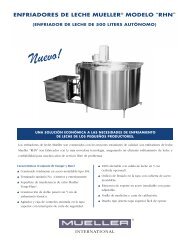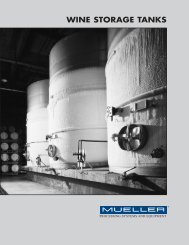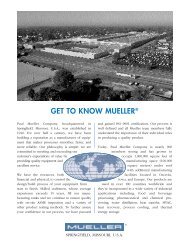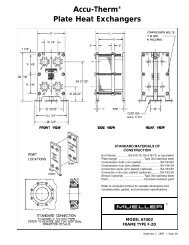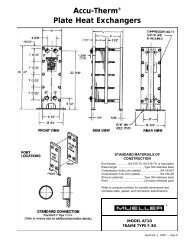ALL ABOUT TEMP-PLATE® - Paul Mueller Company
ALL ABOUT TEMP-PLATE® - Paul Mueller Company
ALL ABOUT TEMP-PLATE® - Paul Mueller Company
Create successful ePaper yourself
Turn your PDF publications into a flip-book with our unique Google optimized e-Paper software.
Temp-Plate is usually welded by the resistance spot<br />
welding process (RSW) and/or the resistance seam<br />
welding process (RSEW).<br />
In resistance spot welding, the metal is pressed together<br />
with two electrodes. After pressure is applied, a current<br />
is passed through the two pieces of base metal; and due<br />
to the resistance to electrical flow at the two base metal<br />
contact surfaces, this area heats up and forms a small<br />
molten puddle. Pressure is retained and the current shut<br />
off; then the molten puddle freezes forming the<br />
weldment between the two pieces. After the nugget is<br />
solid, pressure is released and the part then indexes to<br />
the next spot location for a repeat of the weld cycle.<br />
Resistance seam welding is produced by a series of<br />
overlapping spot welds. Current passes through the metal<br />
as the wheel-shaped electrode, with pressure applied,<br />
rolls over it. The current can also be switched on and off<br />
at preset timed intervals so that a spot weld effect is<br />
made. The width and length of these spot welds can be<br />
controlled by the width of the electrode and current onoff<br />
time.<br />
Photograph shows resistance spot and resistance seam welding.<br />
The perimeter of the RSW Temp-Plate is resistance seam<br />
welded (RSEW) or using a conventional arc-welding<br />
method (i.e.: GTAW, GMAW, etc.).<br />
Single, round resistance spot welds are used where backup<br />
plate thickness does not exceed 1 /4".<br />
Gas metal-arc welding (GMAW-MIG) is required if backup<br />
plate is heavier than 1 /4". This process may also be<br />
used on material lighter than 1 /4" plate when installing<br />
Temp-Plate on a vessel that has already been formed (i.e.,<br />
shell sections, heads, etc.) or when alloy combinations<br />
are not suited for resistance welding.<br />
www.hxrx.com<br />
WELDING METHODS USED<br />
Welding Methods Used to Fabricate <strong>Mueller</strong> Temp-Plate Heat Transfer Surface<br />
In this process, 1 /2" diameter holes are evenly spaced and<br />
filled with the GMAW process or GTAW process filler<br />
metal. In filling these holes, fusion of the jacket material<br />
to the bottom or heavier section is accomplished. This<br />
style of Temp-Plate is referred to as dimpled jacket, and<br />
the perimeter is usually welded with the GMAW process.<br />
An alternate method now available offers the ability to<br />
resistance spot weld the dimpled jacket-style Temp-Plate<br />
with a perimeter weldment made with the GMAW<br />
process.<br />
Section showing gas metal arc welding (MIG) on a dimpled jacket-style Temp-Plate.<br />
Also available with resistance spot welding.<br />
<strong>Mueller</strong> Temp-Plate serpentine pattern.<br />
<strong>Mueller</strong> Temp-Plate steam pattern.<br />
3



